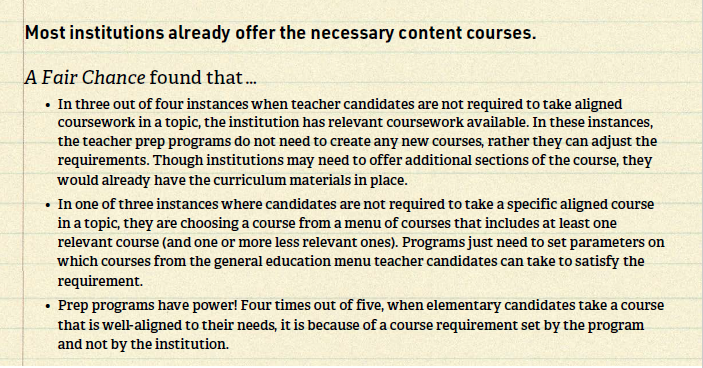A Fair Chance: Simple steps to strengthen and diversify the teacher workforce
Breaking it down: Course requirements
Provide better parameters for selecting from course options that count toward general education requirements for undergraduate students who indicate an interest in teaching.
Often, an institution already offers great content courses – but candidates aren't required to take them. Most of the content coursework that aspiring teachers take comes through the institution's core general education requirements. If the institution gives candidates course choices that are not aligned with what future elementary teachers need, teacher prep programs can take the initiative to set boundaries on these courses. For example, if candidates have a choice of 15 different history courses, the program can require that candidates take the early American history course. By providing more explicit guidance, programs will give teacher candidates clear direction about the course material they should cover.
What's worked for other teacher prep programs?
These are real tips from leaders of the teacher prep programs featured in our list of Programs that Rise Above the Others.
• Examine what your institution already offers: Look through the academic catalogue to identify courses that your institution already offers which directly meet your teacher candidates' needs.
• Use a central office to organize change: Use the provost's office or another central office to bring together deans and create formal processes to address content needs, and to work out logistical details like scheduling courses and saving seats for education majors in content courses.
• Consider the practicalities: Work with content faculty to create a convenient course schedule, to offer necessary courses every semester, or to save seats in courses for teacher candidates.
• Provide guidance to potential teacher candidates before admitting them to the program: Advisors can help teacher candidates sequence their courses to make sure they fulfill all requirements, starting freshman year. Advising sheets that detail course requirements can also help provide guidance to aspiring teacher candidates.
• Build relationships and keep the collaboration going: Integrate content partners into your own processes, e.g., through regular content meetings with education and liberal arts faculty.
• Be vocal about what your candidates need: Ask content faculty to add essential content into courses, or share results from licensure tests and work with faculty to help shore up areas where candidates are consistently weak.
• Front-load content requirements: Require your candidates to take most content before entering the program so that when they're in methods courses, they can focus on learning how to teach content.
• Use a central office to organize change: Use the provost's office or another central office to bring together deans and create formal processes to address content needs, and to work out logistical details like scheduling courses and saving seats for education majors in content courses.
• Consider the practicalities: Work with content faculty to create a convenient course schedule, to offer necessary courses every semester, or to save seats in courses for teacher candidates.
• Provide guidance to potential teacher candidates before admitting them to the program: Advisors can help teacher candidates sequence their courses to make sure they fulfill all requirements, starting freshman year. Advising sheets that detail course requirements can also help provide guidance to aspiring teacher candidates.
• Build relationships and keep the collaboration going: Integrate content partners into your own processes, e.g., through regular content meetings with education and liberal arts faculty.
• Be vocal about what your candidates need: Ask content faculty to add essential content into courses, or share results from licensure tests and work with faculty to help shore up areas where candidates are consistently weak.
• Front-load content requirements: Require your candidates to take most content before entering the program so that when they're in methods courses, they can focus on learning how to teach content.


